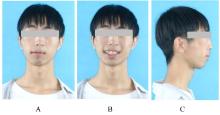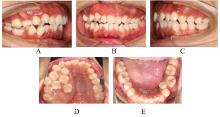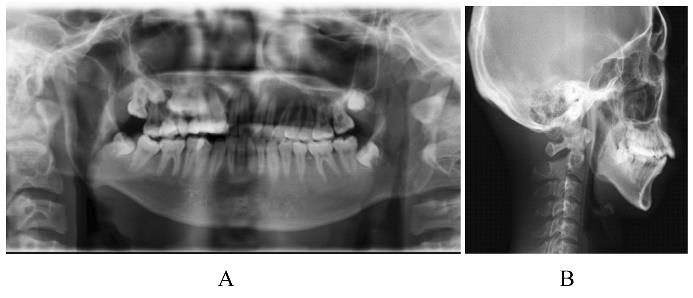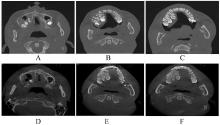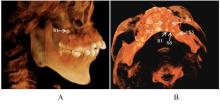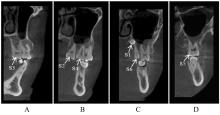| 1 |
葛立宏, 王 旭. 多生牙发生的分子生物学研究进展[J].北京大学学报(医学版),2013,45(4):661-665.
|
| 2 |
王颖姝, 吴世超, 马 玉, 等. CBCT测量超长多生下颌前磨牙1例[J]. 实用口腔医学杂志, 2020, 36(6): 973-975.
|
| 3 |
WANG X P, FAN J B. Molecular genetics of supernumerary tooth formation[J].Genesis,2011,49(4): 261-277.
|
| 4 |
ALVIRA-GONZÁLEZ J, GAY-ESCODA C. Non-syndromic multiple supernumerary teeth: meta-analysis[J]. J Oral Pathol Med, 2012, 41(5): 361-366.
|
| 5 |
AÇIKGÖZ A, AÇIKGÖZ G, TUNGA U, et al. Characteristics and prevalence of non-syndrome multiple supernumerary teeth: a retrospective study[J]. Dentomaxillofac Radiol, 2006, 35(3): 185-190.
|
| 6 |
艾红梅, 刘晓辉. 左上颌第二磨牙颊侧多生牙1例[J]. 实用口腔医学杂志, 2019, 35(3): 356.
|
| 7 |
彭 博, 曾素娟, 葛林虎. 多生牙的研究进展[J]. 口腔医学研究, 2018, 34(2): 209-212.
|
| 8 |
HALL A, ONN A. The development of supernumerary teeth in the mandible in cases with a history of supernumeraries in the pre-maxillary region[J]. J Orthod, 2006, 33(4): 250-255.
|
| 9 |
方 慧, 杨 杰. 非综合征性多生牙的临床特点和诊疗原则[J]. 国际口腔医学杂志, 2018, 45(4): 449-454.
|
| 10 |
刘 婷, 张伟伟, 程 艺, 等. 多位置多形态多生牙1例报道并文献回顾[J]. 中国实用口腔科杂志, 2022, 15(3): 378-380.
|
| 11 |
周芳芳, 贾燕冰. 口腔锥形束CT在上颌埋伏牙诊断中的应用价值研究[J].实用医学影像杂志, 2022, 23(1): 66-68.
|
| 12 |
LAGRAVÈRE M O, CAREY J, TOOGOOD R W, et al. Three-dimensional accuracy of measurements made with software on cone-beam computed tomography images[J]. Am J Orthod Dentofac Orthop, 2008, 134(1): 112-116.
|
| 13 |
ZHAO J H, HUANG C F. The advanced techniques of dentoalveolar surgery[J]. Hua Xi Kou Qiang Yi Xue Za Zhi, 2014, 32(3): 213-216.
|
| 14 |
YAGÜE-GARCÍA J, BERINI-AYTÉS L, GAY-ESCODA C. Multiple supernumerary teeth not associated with complex syndromes: a retrospective study[J]. Med Oral Patol Oral Cir Bucal, 2009, 14(7): E331-E336.
|
| 15 |
GÜNDÜZ K, MUĞLALI M. Non-syndrome multiple supernumerary teeth: a case report[J]. J Contemp Dent Pract, 2007, 8(4): 81-87.
|
| 16 |
ATA-ALI F, ATA-ALI J, PEÑARROCHA-OLTRA D, et al. Prevalence, etiology, diagnosis, treatment and complications of supernumerary teeth[J]. J Clin Exp Dent, 2014, 6(4): e414-e418.
|
| 17 |
刘宪光, 张 君, 李成龙, 等. 558例多生牙临床特点的回顾性分析[J].山东大学学报(医学版), 2017, 55(3): 121-124.
|
| 18 |
HANS M K, SHETTY S, SHEKHAR R, et al. Bilateral supplemental maxillary central incisors: a case report[J]. J Oral Sci, 2011, 53(3): 403-405.
|
| 19 |
LU X, YU F, LIU J J, et al. The epidemiology of supernumerary teeth and the associated molecular mechanism[J]. Organogenesis, 2017, 13(3): 71-82.
|
| 20 |
WANG X X, ZHANG J, WEI F C. Autosomal dominant inherence of multiple supernumerary teeth[J]. Int J Oral Maxillofac Surg, 2007, 36(8): 756-758.
|
| 21 |
TEREZA G P, CARRARA C F, COSTA B. Tooth abnormalities of number and position in the permanent dentition of patients with complete bilateral cleft lip and palate[J].Cleft Palate Craniofac J,2010,47(3):247-252.
|
| 22 |
CAMMARATA-SCALISI F, AVENDAÑO A, CALLEA M. Main genetic entities associated with supernumerary teeth[J]. Arch Argent Pediatr, 2018, 116(6): 437-444.
|
| 23 |
LUBINSKY M, KANTAPUTRA P N. Syndromes with supernumerary teeth[J]. Am J Med Genet A, 2016, 170(10): 2611-2616.
|
| 24 |
ZHANG Z Y, LAN Y, CHAI Y, et al. Antagonistic actions of Msx1 and Osr2 pattern mammalian teeth into a single row[J]. Science, 2009, 323(5918): 1232-1234.
|
| 25 |
吴勇志, 尧 可, 陈思宇, 等.多生牙及其诊断治疗[J]. 国际口腔医学杂志, 2020, 47(3): 311-317.
|
| 26 |
陈 力, 鞠 昊, 公柏娟, 等. 锥形束CT在青少年多生牙诊断中的应用[J]. 吉林大学学报(医学版), 2019, 45(2): 435-438.
|
 )
)
